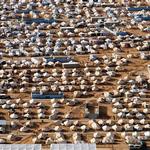Decade of Despair: The Contested Rebuilding of the Nahr al-Bared Refugee Camp, Lebanon, 2007–2017
In mid-2007 the Nahr al-Bared refugee camp near Tripoli was destroyed by the Lebanese Army battling an insurgent Islamist group, Fatah al-Islam. Displacing about 30,000 Palestinian refugees, it was one of the largest internal battles in post-civil war Lebanon. A decade later, the camp has yet to be fully rebuilt; indeed, reconstruction has been slow, confictual, and underfunded. Rebuilding the camp has been contested and delayed by political opposition, funding shortfalls, and complex ownership of land and property. About half of the displaced families have been able to return, the remainder are internally displaced, living temporarily in other camps or rented apartments. This article analyzes the slow-paced reconstruction of the Nahr al-Bared camp and especially what can be learnt from rehousing refugees in a militarized space of exception.
En français: À la mi-2007, le camp de réfugiés de Nahr al-Bared a été détruit par l'armée libanaise alors qu'elle combattait Fatah al-Islam, un groupe de rebelles islamistes. Ce confit, l'un des confits internes les plus importants après la guerre civile libanaise, a déplacé environ 30 000 réfugiés palestiniens. Dix ans plus tard, le camp reste encore à reconstruire entièrement ; en réalité, sa reconstruction est lente, confictuelle et insufsamment financée. Cette reconstruction est contestée et retardée par une opposition politique, par un manque de fonds, et par des problèmes complexes de propriété foncière et patrimoniale. Aujourd'hui, environ la moitié des familles déplacées ont pu retourner au camp, l'autre moitié restant déplacée à l'intérieur du pays, vivant de manière temporaire dans d'autres camps ou dans des appartements loués. Cet article analyse la lente reconstruction du camp de Nahr al-Bared, et tout particulièrement les enseignements qui peuvent être tirés quant au relogement des réfugiés dans un espace militarisé d'exception.







